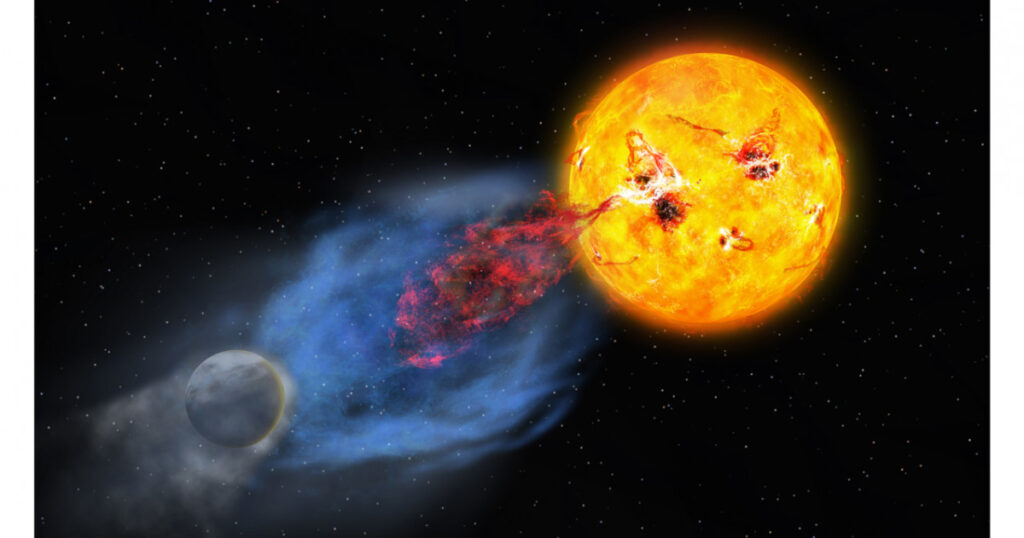
Kyoto, Japan — While often unnoticed from Earth, the Sun is a dynamic star, frequently ejecting massive amounts of plasma into space. These events, known as coronal mass ejections (CMEs), can occur alongside sudden solar flares and sometimes extend far enough to disturb Earth’s magnetosphere. This can result in space weather phenomena such as auroras, geomagnetic storms, and occasionally, damage to power grids.
Scientists have long speculated that during the early days of the Sun and Earth, the Sun’s intense activity, including CMEs, could have significantly influenced the emergence and evolution of life on our planet. Research indicates that young Sun-like stars, which serve as proxies for our Sun’s youthful state, often produce flares much stronger than any recorded in modern history.
Massive CMEs from the early Sun might have dramatically affected the environments of Earth, Mars, and Venus. However, the extent to which these young stellar explosions resemble solar-like CMEs remains uncertain. Recent advancements have allowed the detection of the cool plasma of CMEs through optical observations from the ground. Yet, the high velocity and presumed frequent occurrence of powerful CMEs in the past have been elusive.
Unraveling the Mysteries of the Young Sun
To address this enigma, an international team of researchers, including Kosuke Namekata from Kyoto University, embarked on a mission to determine whether young Sun-like stars produce CMEs similar to those of our Sun. “What inspired us most was the long-standing mystery of how the young Sun’s violent activity influenced the nascent Earth,” Namekata explained.
By integrating resources from space- and ground-based facilities across Japan, Korea, and the United States, the team aimed to reconstruct the conditions of our solar system billions of years ago. Their analysis involved simultaneous ultraviolet observations from the Hubble Space Telescope and optical observations from ground-based telescopes in Japan and Korea, focusing on the young solar analogue EK Draconis.
Breakthrough Observations
Hubble’s observations targeted far-ultraviolet emission lines sensitive to hot plasma, while the ground-based telescopes observed the hydrogen Hα line, which traces cooler gases. This simultaneous, multi-wavelength spectroscopic approach enabled the research team to capture both the hot and cool components of the ejection in real time.
Their observations provided the first evidence of a multi-temperature coronal mass ejection from EK Draconis. The team discovered that hot plasma, at temperatures of 100,000 degrees Kelvin, was ejected at speeds between 300 to 550 kilometers per second. This was followed approximately ten minutes later by a cooler gas, around 10,000 degrees, ejected at 70 kilometers per second.
The hot plasma carried significantly more energy than the cool plasma, suggesting that frequent, strong CMEs in the past could drive powerful shocks and energetic particles capable of eroding or chemically altering early planetary atmospheres.
Implications for Planetary Habitability
Theoretical and experimental studies support the notion that strong CMEs and energetic particles play a critical role in initiating biomolecules and greenhouse gases, which are essential for the emergence and maintenance of life on early planets. Consequently, this discovery has profound implications for understanding planetary habitability and the conditions under which life emerged on Earth, and potentially, elsewhere in the universe.
The research team emphasized that the success of this study was a result of international collaboration and precise coordination between space- and ground-based observatories. “We were happy to see that, although our countries differ, we share the same goal of seeking truth through science,” remarked Namekata.
Looking Ahead
This groundbreaking research not only sheds light on the early solar system’s dynamics but also opens new avenues for exploring the habitability of exoplanets orbiting young, active stars. As scientists continue to unravel the mysteries of our cosmic origins, the findings from EK Draconis serve as a crucial piece of the puzzle, offering insights into the forces that shaped the environments of early planets.
Future studies will likely build on this foundation, utilizing advanced technology and international cooperation to further our understanding of the universe’s formative years and the potential for life beyond Earth.





